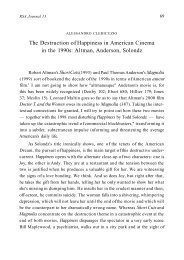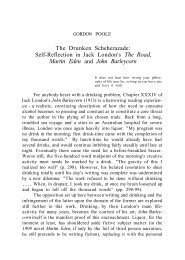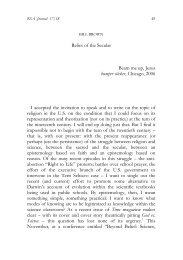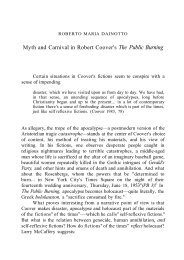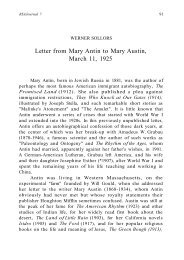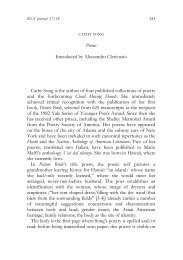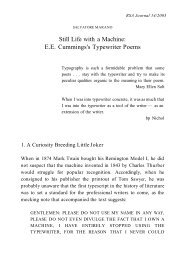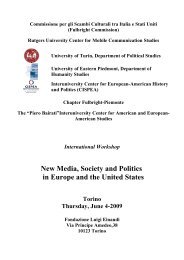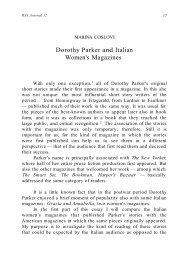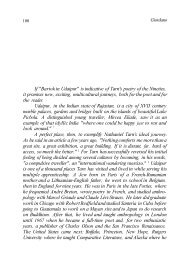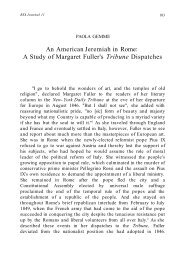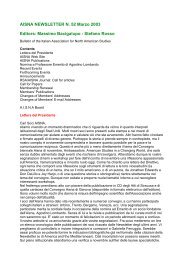A Nation with the Soul of a Church? The Strange Career of Religion ...
A Nation with the Soul of a Church? The Strange Career of Religion ...
A Nation with the Soul of a Church? The Strange Career of Religion ...
Create successful ePaper yourself
Turn your PDF publications into a flip-book with our unique Google optimized e-Paper software.
RSA 15-16 (2004-2005)<br />
BERNDT OSTENDORF<br />
A <strong>Nation</strong> <strong>with</strong> <strong>the</strong> <strong>Soul</strong> <strong>of</strong> a <strong>Church</strong>?<br />
<strong>The</strong> <strong>Strange</strong> <strong>Career</strong> <strong>of</strong> <strong>Religion</strong> in America:<br />
A View from Europe 1<br />
For most Europeans <strong>the</strong> role <strong>of</strong> religion in American politics is a vexing<br />
puzzle that has become, after <strong>the</strong> collusion <strong>of</strong> neocons and <strong>the</strong>ocons<br />
around George W. Bush, a full-fledged enigma. A panel in New York<br />
<strong>with</strong> European intellectuals drawn from <strong>the</strong> political Left and Right<br />
ended on a sullen note: "<strong>The</strong> role <strong>of</strong> religion in U.S. politics was an<br />
affront to European secularism" (Anderson 143). Behind this transatlantic<br />
discord <strong>the</strong>re is a longer story <strong>of</strong> crossed purposes and mutual misunderstanding.<br />
As early as 1830 <strong>the</strong> French aristocrat Alexis de Tocqueville<br />
noted <strong>with</strong> surprise that in <strong>the</strong> U.S.A. religion and democracy<br />
were not in opposition (Tocqueville I, 310ff.). Unlike in Europe <strong>the</strong>re was<br />
a marked compatibility, if not reciprocity, between religious and democratic<br />
passions (I, 319). After all, had not <strong>the</strong> American clergy supported<br />
<strong>the</strong> revolutionary struggle (I. 310-18)? James Bryce, British ambassador<br />
to <strong>the</strong> U.S. from 1907 to 1913, noticed that Christianity in America,<br />
although based on doctrinally weak voluntary associations, had become<br />
<strong>the</strong> "common law <strong>of</strong> <strong>the</strong> United States" (Bryce 560-1). And <strong>the</strong> English<br />
novelist G. K. Chesterton concluded in 1920 that <strong>the</strong> U.S. was "a nation<br />
<strong>with</strong> <strong>the</strong> soul <strong>of</strong> a church" (Mead). 2 Chesterton captured <strong>the</strong> synergy<br />
between religion and nationalism and called it "civil religion" which he,<br />
like Max Weber, attributed to <strong>the</strong> influence <strong>of</strong> Puritans and Calvinists on<br />
<strong>the</strong> American body politic.<br />
But how do <strong>the</strong> observations <strong>of</strong> Tocqueville, Chesterton and Bryce<br />
square <strong>with</strong> <strong>the</strong> institutional separation <strong>of</strong> church and state? For <strong>the</strong><br />
republic was conceived by <strong>the</strong> founding fa<strong>the</strong>rs as a radically secular state<br />
<strong>with</strong> an enlightened constitution, a document which does not mention<br />
God at all. This is remarkable in view <strong>of</strong> <strong>the</strong> current brouhaha over <strong>the</strong><br />
constitution in supposedly secular Europe where a sizeable portion <strong>of</strong> <strong>the</strong>
170 Berndt Ostendorf<br />
parliament demands that God be mentioned in <strong>the</strong> preamble. In <strong>the</strong> U.S.<br />
God was referred to in <strong>the</strong> ratifying conventions for <strong>the</strong> constitution, but<br />
only abstractly as "supreme ruler <strong>of</strong> <strong>the</strong> universe" (Bailyn 547). As a follower<br />
<strong>of</strong> <strong>the</strong> French and Scottish enlightenments, Thomas Jefferson saw a<br />
wall <strong>of</strong> separation between church and state. He, James Madison and particularly<br />
George Washington were sympa<strong>the</strong>tic to freemasonry. To this day<br />
<strong>the</strong> iconography <strong>of</strong> <strong>the</strong> one-dollar note speaks for <strong>the</strong> historic impact <strong>of</strong> that<br />
decidedly secular tradition. Like <strong>the</strong>ir friend, Benjamin Franklin, <strong>the</strong>y were<br />
at best agnostics or deists who kept a respectful distance to God and <strong>the</strong><br />
established church. In <strong>the</strong> Federalist Papers James Madison had argued eloquently<br />
for a perfect separation between ecclesiastical and civil matters.<br />
<strong>The</strong> first amendment secured <strong>the</strong>se positions <strong>of</strong><strong>the</strong> Federalist debate: "Congress<br />
shall make no law respecting an establishment <strong>of</strong> religion, or prohibiting<br />
<strong>the</strong> free exercise <strong>the</strong>re<strong>of</strong>. .."<br />
Eight years later congress had an occasion to test <strong>the</strong> first amendment<br />
in political practice. At this time <strong>the</strong> young republic was developing new<br />
markets in <strong>the</strong> Mediterranean. In 1796 U.S. Consul General Joel Barlow<br />
negotiated <strong>the</strong> treaty <strong>of</strong> Tripoli <strong>with</strong> Muslim representatives <strong>of</strong> <strong>the</strong> Barbary<br />
Coast in North Africa. <strong>The</strong> Barbary States were <strong>the</strong> rogue nations <strong>of</strong> <strong>the</strong>ir<br />
day who made money through piracy and extortion on <strong>the</strong> high seas. <strong>The</strong><br />
treaty was designed to curb <strong>the</strong> raids <strong>of</strong> Muslim pirates on <strong>the</strong> American<br />
merchant marine, hence its wording was penned to prevent religion from<br />
interfering <strong>with</strong> <strong>the</strong> commercial progress <strong>of</strong> <strong>the</strong> young republic. Congress<br />
recognized <strong>the</strong>se secular priorities and ratified <strong>the</strong> treaty by unanimous<br />
vote. It was signed into law by President John Adams in 1797.<br />
As <strong>the</strong> government <strong>of</strong> <strong>the</strong> U nited States is not in any sense founded on <strong>the</strong><br />
Christian <strong>Religion</strong>, - as it has in itself no character <strong>of</strong> enmity against <strong>the</strong><br />
laws, religion or tranquillity <strong>of</strong> Messelmen [sic], - and as <strong>the</strong> States never have<br />
entered into any war or act <strong>of</strong> hostility against any Mohammedan<br />
nation, it is declared by <strong>the</strong> parties that no pretext arising from religious<br />
opinion shall ever interrupt <strong>the</strong> harmony existing between <strong>the</strong> two countries. 3<br />
Would a similar treaty <strong>with</strong> <strong>the</strong> rogue nations <strong>of</strong> today, say <strong>with</strong> Iran,<br />
Syria or Libya, be conceivable and would it receive a unanimous vote in
<strong>Religion</strong> in America: A View from Europe<br />
Congress? Not if we go by current political leaders and <strong>the</strong>ir understanding<br />
<strong>of</strong> <strong>the</strong> relationship between religion and politics? <strong>The</strong> platform<br />
<strong>of</strong> <strong>the</strong> Republican party <strong>of</strong> Texas states unequivocally: "<strong>The</strong> Republican<br />
Party <strong>of</strong> Texas affirms <strong>the</strong> United States <strong>of</strong> America is a Christian<br />
nation..." On <strong>the</strong> occasion <strong>of</strong> <strong>the</strong> Republican convention Senator Sam<br />
Brownback from Kansas urged his party on 3 Sept. 2004 to reconsider<br />
<strong>the</strong> separation <strong>of</strong> church and state, and Tom Delay, Republican majority<br />
speaker in <strong>the</strong> house, left no doubt as to his religious roots or credentials:<br />
171<br />
Only Christianity <strong>of</strong>fers a comprehensive worldview that covers all areas <strong>of</strong> life<br />
and thought, every aspect <strong>of</strong> creation. Only Christianity <strong>of</strong>fers a way to live in<br />
response to <strong>the</strong> realities that we find in this world — only Christianity.<br />
(Cooperman A 05)<br />
Nominally George W. Bush belongs to a mainline religion — he was raised<br />
Episcopalian and thanks to his wife is today a Methodist, but he testified<br />
as a born-again. Thus his world view, particularly as it surfaces in his political<br />
rhetoric, must be called evangelical. His first attorney general, John<br />
Ashcr<strong>of</strong>t, is a member <strong>of</strong> a premillenarian denomination <strong>with</strong> an apocalyptic<br />
world view expecting Armageddon and <strong>the</strong> second coming <strong>of</strong> Christ<br />
(and <strong>the</strong> conversion <strong>of</strong> <strong>the</strong> Jews) to be just around <strong>the</strong> corner. <strong>The</strong> willingness<br />
<strong>of</strong> <strong>the</strong> new political class to embed foreign policy decisions in religious<br />
rhetoric stands in marked contrast to <strong>the</strong> institutional secularism <strong>of</strong><br />
<strong>the</strong> founding fa<strong>the</strong>rs. <strong>The</strong> current mood marks a turning point in <strong>the</strong> role<br />
<strong>of</strong> religion and secularism in American public life.<br />
Most European observers tend to dismiss <strong>the</strong> new religious turn in<br />
American politics ei<strong>the</strong>r as a loopy ideology ("opium for <strong>the</strong> people") or<br />
as a cynical ploy to curry favor <strong>with</strong> religious voters. <strong>The</strong>refore <strong>the</strong>y<br />
would just as soon ignore it. This would be a serious mistake. We are<br />
dealing <strong>with</strong> a new religious awakening and a moral realignment <strong>with</strong><br />
far-reaching consequences for policy making in years to come. And yet,<br />
to <strong>the</strong> religious historian <strong>the</strong>re is precious little that is truly new. One<br />
secret for <strong>the</strong> continued vitality <strong>of</strong> religion in <strong>the</strong> U.S. lies in <strong>the</strong> very<br />
logic <strong>of</strong> <strong>the</strong> First Amendment which put in place a powerful dialectical
172 Berndt Ostendorf<br />
tension between institutional secularism and a series <strong>of</strong> grass roots religious<br />
responses. Thirty years after its ratification James Madison praised<br />
<strong>the</strong> wisdom <strong>of</strong> this reactive logic in a letter to Edward Livingston, adding<br />
a comment that reveals his ulterior motives: "<strong>Religion</strong> flourishes in<br />
greater purity, <strong>with</strong>out than <strong>with</strong> <strong>the</strong> aid <strong>of</strong> Govt" (Koch 465-6). 4 He<br />
expected that <strong>the</strong> institutional secularism <strong>of</strong> <strong>the</strong> Republic would in <strong>the</strong><br />
long run encourage religious energies ra<strong>the</strong>r than suppress <strong>the</strong>m. He figured<br />
that it would be best to leave <strong>the</strong> production and organization <strong>of</strong> religious<br />
energies to <strong>the</strong> market, that is to <strong>the</strong> vote and control <strong>of</strong> <strong>the</strong> consumer.<br />
In short, <strong>the</strong> separation <strong>of</strong> church and state has given a boost to a<br />
market oriented religion. Divesting established religion <strong>of</strong> all power and<br />
turning <strong>the</strong> religious controls over to <strong>the</strong> customer, this constitutes Madison's<br />
conservative cunning in preparing <strong>the</strong> ground for an exceptional<br />
American popular religiosity <strong>with</strong> a patriotic spin.<br />
Since <strong>the</strong> times <strong>of</strong> <strong>the</strong> founders <strong>the</strong> religious market has come a long<br />
way, but where exactly are we now? Have <strong>the</strong> formerly secular institutions<br />
been over-layered or even displaced by <strong>the</strong> tidal wave <strong>of</strong> religious passions<br />
pushed relentlessly forward by <strong>the</strong> booming religious market? Is <strong>the</strong> institutional<br />
secularism in danger <strong>of</strong> being dislocated by <strong>the</strong> growing <strong>the</strong>ocratic<br />
passions <strong>of</strong> leading politicians and <strong>the</strong>ir clienteles? Are not <strong>the</strong><br />
United States today by common consent a Christian nation? <strong>The</strong> question<br />
arises: Are we witnessing a return to an older <strong>the</strong>ocratic disposition, or is<br />
this a new and "post-secular" religiosity that is qualitatively and politically<br />
different? What long range effect does <strong>the</strong> commodification <strong>of</strong> religion<br />
have? Does it set limits to its doctrinal import and thus curtail its influence<br />
on politics? Is commodification in fact a new, subtle form <strong>of</strong> secularization?<br />
Are we dealing <strong>with</strong> a form <strong>of</strong> religion that has more to do <strong>with</strong><br />
individualized life-style politics, less <strong>with</strong> classic religious doctrine? This<br />
is ground for much debate on both sides <strong>of</strong> <strong>the</strong> Atlantic. A key question<br />
is, what were <strong>the</strong> intentions <strong>of</strong> <strong>the</strong> founders? It seems that such historical<br />
knowledge has been dimmed over time; indeed <strong>the</strong>re is an increased revisionist<br />
debate by Christian-nation advocates that <strong>the</strong> intentions <strong>of</strong> <strong>the</strong><br />
founders <strong>with</strong> respect to religion were different from what <strong>the</strong> First<br />
Amendment says. This change <strong>of</strong> interpretation may have to do <strong>with</strong> <strong>the</strong>
<strong>Religion</strong> in America: A View from Europe<br />
measurable changes in <strong>the</strong> religious life <strong>of</strong> <strong>the</strong> republic since <strong>the</strong> founding<br />
fa<strong>the</strong>rs. More people attend church today (60%) than in 1789 when Finke<br />
and Stark estimated a mere 17% churchgoers. <strong>The</strong> sense <strong>of</strong> national identity<br />
has undergone a pr<strong>of</strong>ound change too, and political realignment has<br />
taken a religious turn. <strong>The</strong>re is currently a partisan division between those<br />
who go to church and vote overwhelmingly Republican and those who<br />
don't and vote Democrat. But <strong>the</strong>re is also a growing recognition that<br />
Americans base <strong>the</strong>ir national identity, including <strong>the</strong>ir quotidian patriotism,<br />
on beliefs that have a religious origin. This symbiosis <strong>of</strong> a robust<br />
nationalism and commodified religion makes secular European observers<br />
nervous. To unravel this puzzle <strong>of</strong> religion and politics from a transatlantic<br />
perspective and to move beyond stereotypes let me start <strong>with</strong> six working<br />
hypo<strong>the</strong>ses that mark <strong>the</strong> differences in <strong>the</strong> historical unfolding <strong>of</strong> <strong>the</strong><br />
American religious experience.<br />
First: <strong>The</strong> secularization <strong>of</strong> <strong>the</strong> public sphere, which we in Europe<br />
associate <strong>with</strong> <strong>the</strong> French revolution and <strong>with</strong> Napoleon's radical disenfranchisement<br />
<strong>of</strong> <strong>the</strong> church, did not play itself out in quite <strong>the</strong> same way<br />
in <strong>the</strong> U.S. Whereas <strong>the</strong> modernizing thrust <strong>of</strong> secularization reached certain<br />
cosmopolitan segments <strong>of</strong> <strong>the</strong> population, it did not affect <strong>the</strong> lower<br />
or middle classes. 5 Although <strong>the</strong> forces <strong>of</strong> modernization, which Max<br />
Weber names as <strong>the</strong> primal causes <strong>of</strong> secularization, were in <strong>the</strong> U.S. more<br />
rigorous than in Europe, <strong>the</strong>y did not lead to a disenchantment <strong>with</strong> religion.<br />
<strong>The</strong> explanation for this development lies in <strong>the</strong> logic <strong>of</strong> <strong>the</strong> First<br />
Amendment: <strong>The</strong> institutional disestablishment <strong>of</strong> religion combined<br />
<strong>with</strong> <strong>the</strong> empowerment <strong>of</strong> individual believers led to its phenomenal success<br />
on <strong>the</strong> free market.<br />
Second: After <strong>the</strong> foundation <strong>of</strong> a secular republic a process <strong>of</strong> reactive<br />
desecularization has set in, first regionally, <strong>the</strong>n nationally and more<br />
in <strong>the</strong> lower to middle than in <strong>the</strong> upper and educated classes. Animated<br />
by <strong>the</strong> First Amendment's "free exercise" and protected by <strong>the</strong> "antiestablishment<br />
clause" a series <strong>of</strong> popular religious reactions from <strong>the</strong> 18th<br />
to <strong>the</strong> 21st centuries occurred. <strong>The</strong> last <strong>of</strong> <strong>the</strong>se awakenings began after<br />
<strong>the</strong> liberal revolutions <strong>of</strong> <strong>the</strong> sixties which provoked popular and regional<br />
responses. Since <strong>the</strong>n <strong>the</strong> formerly "silent" or "moral majorities" have<br />
173
174 Berndt Ostendorf<br />
become politically active. After <strong>the</strong> prayer-in-school decision in 1962<br />
and after Rowe vs. Wade in 1973 desecularization accelerated rapidly<br />
and seriously impacted <strong>the</strong> national political arena in a divisive fashion<br />
pitting a conservative moralism against a "secular humanism." Out <strong>of</strong><br />
this confrontation grew <strong>the</strong> so-called culture wars <strong>with</strong> <strong>the</strong>ir politics <strong>of</strong><br />
denunciation and resentment (Frank). 6<br />
Third: <strong>The</strong> American political arena is energized by a pendulum<br />
swing between secular and religious passions. Within this highly<br />
charged and divided battle zone new forms <strong>of</strong> religion have emerged<br />
whose types <strong>of</strong> worship and performance styles are quite (post)modern.<br />
<strong>The</strong>se are designer-religions attuned to <strong>the</strong> metaphysical needs <strong>of</strong> those<br />
individuals who grew up in that melodramatic confrontation.<br />
Fourth: <strong>The</strong> new religious turn is energized and channeled by popular<br />
culture. Over <strong>the</strong> course <strong>of</strong>American history <strong>the</strong>re has been a cumulative<br />
indigenization <strong>of</strong> popular, religious, apocalyptic and millenarian<br />
fantasies <strong>of</strong>religious fringe groups that fled European persecution. <strong>The</strong>se<br />
found a welcome home in America where <strong>the</strong>y could develop <strong>the</strong>ir<br />
exceptional character in an open religious market. 7 Particularly <strong>the</strong> premillenarian,<br />
Gothic and melodramatic fantasies <strong>of</strong> <strong>the</strong> apocalypse have<br />
found a niche in <strong>the</strong> popular culture market as <strong>the</strong> success <strong>of</strong> Tim<br />
LaHaye's and Jerry Jenkins' Left Behind series testifies (Boyer).<br />
Fifth: <strong>The</strong> demands <strong>of</strong> <strong>the</strong> market have honed <strong>the</strong> ritual and shaped<br />
<strong>the</strong> choreography <strong>of</strong> American religions and have over time lead to an<br />
increasing commodification <strong>of</strong> religion and to its mise en scene as spectacle.<br />
<strong>The</strong> popular culture market has hijacked religious symbolism and<br />
has brought religious rhetoric as added moral value into <strong>the</strong> secular<br />
sphere. We may roughly distinguish four groups that are competing in<br />
<strong>the</strong> public sphere: First, <strong>the</strong> pre-secular fundamentalists <strong>of</strong> <strong>the</strong> "old time<br />
religion"; second, an urban educated class belonging to mainline religions<br />
that is comfortable <strong>with</strong> a separation <strong>of</strong> church and state; third,<br />
post-secular revivalists and evangelicals on <strong>the</strong> one hand; and fourth,<br />
postmodern life-style and designer religions <strong>of</strong>fering metaphysical nurture<br />
in a complex world on <strong>the</strong> o<strong>the</strong>r.<br />
Sixth: Tocqueville understood <strong>the</strong> symbiosis <strong>of</strong> millenarian and
<strong>Religion</strong> in America: A View from Europe<br />
175<br />
grass roots democratic passions, also <strong>the</strong>ir absorption into a religiously<br />
based popular patriotism. He wrote: "Thus religious zeal is perpetually<br />
warmed in <strong>the</strong> United States by <strong>the</strong> fires <strong>of</strong> patriotism" (I 31 7). This<br />
fusion resulted in a sacralization <strong>of</strong> national rhetoric, which has over<br />
time become a habit <strong>of</strong> <strong>the</strong> American executive <strong>of</strong>fice. <strong>The</strong> president is<br />
expected to speak as <strong>the</strong> high priest <strong>of</strong> civil religion, particularly when<br />
addressing matters <strong>of</strong> national concern. Europeans tend to find such<br />
executive rhetoric hypocritical and hard to stomach. 8<br />
<strong>The</strong>se six deviations from <strong>the</strong> European secularization paradigm<br />
have given a special religious spin to America's political culture which<br />
seems odd to many Europeans. I shall try to chart <strong>the</strong> cumulative<br />
momentum <strong>of</strong> this mysterious symbiosis <strong>of</strong> politics and religion in<br />
fourteen historical transformations that are placed in a rough sequence<br />
from Colonial times to <strong>the</strong> present. Each transformation represents a<br />
new stage in <strong>the</strong> cumulative Americanization <strong>of</strong> religion and contributes<br />
to its exceptional character.<br />
1. Myths <strong>of</strong> Conquest and <strong>the</strong> Foundational Ideology<br />
<strong>The</strong> motivations and impulses which in <strong>the</strong> 16th and 17th centuries led<br />
to <strong>the</strong> peopling <strong>of</strong> <strong>the</strong> Americas contained strong religious yearnings.<br />
Even before <strong>the</strong> so-called discovery <strong>of</strong>America <strong>the</strong> reconquista <strong>of</strong><strong>the</strong> Spanish<br />
peninsula was driven by religious motives, as was <strong>the</strong> entire project <strong>of</strong><br />
<strong>the</strong> Reformation <strong>with</strong> its self-propelling missionary zeal. <strong>The</strong> conviction<br />
<strong>of</strong> many groups to act as an agent <strong>of</strong> God's purpose and to be a chosen<br />
people or a redeemer nation speaks for itself. <strong>The</strong>se utopian projections<br />
went into <strong>the</strong> making <strong>of</strong> <strong>the</strong> foundational ideology <strong>of</strong> Massachusetts Bay<br />
and created a narcissistic myth <strong>of</strong> origin <strong>with</strong> high demands on <strong>the</strong> elected<br />
people. John Cotton reminded his congregation: "Where much is<br />
given, much is demanded," thus instilling a sense <strong>of</strong> civic gratitude<br />
which persists until this day. For <strong>the</strong> entire world to see, a city upon a hill<br />
should vindicate <strong>the</strong> god-given experiment, an experiment which should<br />
unfold in time and become manifest in <strong>the</strong> historical practice <strong>of</strong> its indi
176 Berndt Ostendorf<br />
vidual members. <strong>The</strong> norms <strong>of</strong> this new commonwealth were recorded in<br />
a covenant "knit toge<strong>the</strong>r by voluntary consent." <strong>The</strong> stakes were high,<br />
so high that after one generation <strong>the</strong> new Americans had <strong>the</strong> feeling <strong>of</strong><br />
falling behind <strong>the</strong>ir intended goals necessitating a halfway covenant. 9 <strong>The</strong><br />
city upon a hill was in permanent danger <strong>of</strong> slipping and becoming a sink<br />
<strong>of</strong> iniquity. This danger <strong>of</strong> imminent moral decline was heralded in innumerable<br />
sermons and jeremiads. However, <strong>the</strong> jeremiad was always<br />
prompted by an optimism, that such decline could be stopped in time by<br />
proper reform. Thus this tension between real or imagined fear <strong>of</strong> decline<br />
and <strong>the</strong> energetic reversal has become a strong motive <strong>of</strong> all reform movements<br />
in <strong>the</strong> U.S. Typically <strong>the</strong>se would like to return to a better previous<br />
condition, or expressed differently, <strong>the</strong>y want to correct <strong>the</strong> ill effects <strong>of</strong><br />
<strong>the</strong> most recent modernization in order to return to a sacred tradition<br />
embedded in <strong>the</strong> myth <strong>of</strong> origin and thus embark on a new and much<br />
improved future. Here lies one core impulse for <strong>the</strong> vitality <strong>of</strong> religious<br />
revivals and for <strong>the</strong> stability <strong>of</strong> a situational conservatism. <strong>The</strong> proper text<br />
type is that <strong>of</strong> <strong>the</strong> jeremiad which is designed to prime <strong>the</strong> pump <strong>of</strong><br />
reform. <strong>The</strong>refore it does not surprise that many books <strong>of</strong> social criticism<br />
are written in <strong>the</strong> style <strong>of</strong> <strong>the</strong> jeremiad. Regardless <strong>of</strong> illegibility <strong>the</strong>y end<br />
up on <strong>the</strong> unread bestseller lists, for <strong>the</strong>y touch <strong>the</strong> central nervous system<br />
<strong>of</strong> national identity. <strong>The</strong>y are an expression not only <strong>of</strong> a feeling <strong>of</strong> crisis<br />
that <strong>the</strong> American dream is in grave danger, but also <strong>of</strong> <strong>the</strong> optimism, that<br />
<strong>with</strong> a change <strong>of</strong> <strong>the</strong> bad ways on <strong>the</strong> part <strong>of</strong> <strong>the</strong> faithful its fulfillment is<br />
just around <strong>the</strong> corner.<br />
2. <strong>The</strong> Tradition <strong>of</strong> Dissent<br />
<strong>The</strong> dynamics <strong>of</strong> settlement in <strong>the</strong> New World (1607-1760) was choreographed<br />
by <strong>the</strong> export <strong>of</strong> European religious radicalism and its divisive<br />
secessions. <strong>The</strong> founding fa<strong>the</strong>rs <strong>of</strong> New England were "non-conformists"<br />
who resented <strong>the</strong> "acts <strong>of</strong> uniformity" <strong>of</strong> <strong>the</strong> established church. Among<br />
<strong>the</strong>m we find many sectarians and antinomian spirits who wanted a better<br />
religion and politics. <strong>The</strong>y were pushed out by <strong>the</strong> corrupt feudal
<strong>Religion</strong> in America: A View from Europe<br />
177<br />
powers in Europe and pulled in by <strong>the</strong> relative freedom in <strong>the</strong> New<br />
World. A concerted spirit <strong>of</strong> dissent united religious individualists and<br />
seekers <strong>of</strong> God to establish freedom in <strong>the</strong> New World. <strong>The</strong> tradition <strong>of</strong><br />
"here I stand" streng<strong>the</strong>ned <strong>the</strong> individual consciousness and <strong>the</strong> antiauthoritarian<br />
particularism; it established <strong>the</strong> tradition <strong>of</strong> <strong>the</strong> right to dissent<br />
and <strong>the</strong> belief in individual responsibility. This frame <strong>of</strong> mind motivated<br />
<strong>the</strong> dissenters in <strong>the</strong>ir own midst — say Anne Hutchinson and Roger<br />
Williams - to fight <strong>the</strong> emergence. <strong>of</strong> new power structures. Hutchinson<br />
challenged <strong>the</strong> patriarchy <strong>of</strong> religious authority in general, Williams stood<br />
for a separation <strong>of</strong> church and state — at a time when Massachusetts Bay<br />
was a patriarchal <strong>the</strong>ocracy. Indeed <strong>the</strong>re was much intolerance against dissenters<br />
<strong>with</strong>in <strong>the</strong> New World: <strong>The</strong> radical beliefto be in possession <strong>of</strong> <strong>the</strong><br />
correct faith led to a zero-sum game <strong>with</strong>in a Manichean dispensation.<br />
This ideological rigor is at work to this day and may help to explain <strong>the</strong><br />
binary options <strong>of</strong> political correctness. You are ei<strong>the</strong>r good or bad, for <strong>the</strong><br />
coalition <strong>of</strong> <strong>the</strong> willing or against it; you are ei<strong>the</strong>r born again or left<br />
behind, smoker or militant non-smoker. Bumper stickers reinforce such<br />
binary alternatives: "America love it or leave it." Those lukewarm middling<br />
positions, so typical <strong>of</strong> Europe, find no place in this zero-sum game.<br />
3. Structural Exclusion<br />
In Europe whose political centers were subject to <strong>the</strong> feudal dictum cuius<br />
regia, eius religio (which captures <strong>the</strong> collusion <strong>of</strong> feudal authority and religious<br />
power) <strong>the</strong> churches were gradually cleansed <strong>of</strong> deviant religious<br />
fantasies. Incompatible faiths were forcibly ejected both by <strong>the</strong> religious<br />
and by <strong>the</strong> secular authorities, and <strong>the</strong> New World became <strong>the</strong> receptacle<br />
<strong>of</strong> <strong>the</strong>se unwanted religions. Soon radical, democratic, and separatist<br />
fringe groups <strong>of</strong> <strong>the</strong> reformation <strong>with</strong>drew to <strong>the</strong> politically safe periphery<br />
<strong>of</strong> <strong>the</strong> colonies. <strong>The</strong> Puritans, Pilgrims, Anabaptists, Mennonites,<br />
Hutterites, Amish, Herrenhu<strong>the</strong>rs, Schwenckfelders, Diggers, Quakers,<br />
Pietists and Shakers — all ended up in North America, some after a detour<br />
via Russia. In 1855 Philip Schaffaptly called America "<strong>the</strong> Phoenix grave
178 Berndt Ostendorf<br />
... <strong>of</strong> all European churches and sects" (Mead 263). <strong>The</strong>se religious<br />
groups bonded on <strong>the</strong> basis <strong>of</strong> a voluntary consent <strong>of</strong> individual dissenters.<br />
<strong>The</strong>y implanted local habits which later would become <strong>the</strong> grass<br />
roots <strong>of</strong> democracy. As Soren Kierkegaard put it: Radical Protestantism<br />
threw out King or Pope and set <strong>the</strong> public on <strong>the</strong> throne. On <strong>the</strong> American<br />
continent religious groups did not define <strong>the</strong>mselves on <strong>the</strong> basis <strong>of</strong><br />
a hegemonic, top-down doctrine ("Roma locuta, causa finita"), but on <strong>the</strong><br />
basis <strong>of</strong> <strong>the</strong>ir practical Christianity, basically through a visible moral life<br />
in plain daylight, as Hawthorne put it. American religiosity on <strong>the</strong> basis<br />
<strong>of</strong> its voluntaristic origin — and this is an important difference from<br />
Europe — never stood in opposition to a grass-roots politics <strong>of</strong> individual<br />
rights. While Europe held on to deeply rooted ecclesias, America<br />
received footloose denominations. <strong>The</strong>ir survival depended on <strong>the</strong>ir ability<br />
to solicit new converts in <strong>the</strong> public sphere. This enhanced <strong>the</strong>ir personal<br />
mission and it prepared <strong>the</strong> ground for learning <strong>the</strong> high art <strong>of</strong> religious<br />
mobilization.<br />
4. Distance between Metropolis and Colony<br />
<strong>The</strong> geographic location <strong>of</strong> <strong>the</strong> colonies on <strong>the</strong> periphery <strong>of</strong> <strong>the</strong> Western<br />
world led to a gradual uncoupling <strong>of</strong> <strong>the</strong> New World faithful from<br />
<strong>the</strong> centers <strong>of</strong> ecclesiastic power in Europe. <strong>The</strong> sheer distance between<br />
Virginia and <strong>the</strong> homeland disrupted <strong>the</strong> chain <strong>of</strong> command. <strong>The</strong><br />
authority <strong>of</strong> <strong>the</strong> central ecclesia was no longer active, <strong>the</strong> power <strong>of</strong> <strong>the</strong><br />
bishops waned and <strong>the</strong> entire idea <strong>of</strong> belonging to a high church was<br />
perforated by each new day <strong>of</strong> congregational practice in <strong>the</strong> New<br />
World. Local clergy in Virginia "went native", and <strong>the</strong> faithful took <strong>the</strong><br />
running <strong>of</strong> religion into <strong>the</strong>ir own hands. As a consequence <strong>the</strong> authority<br />
<strong>of</strong> <strong>the</strong> local congregation increased vis a vis <strong>the</strong> national church.<br />
Even <strong>with</strong>in <strong>the</strong> more established Anglican groups this fact streng<strong>the</strong>ned<br />
<strong>the</strong> budding grass roots democracy and weakened <strong>the</strong> authority <strong>of</strong><br />
<strong>the</strong> episcopacy or <strong>the</strong> institutional power <strong>of</strong> <strong>the</strong> home church. Westminster<br />
was appalled by what happened in Virginia. Religious self-rule
<strong>Religion</strong> in America: A View from Europe<br />
179<br />
<strong>with</strong>in local congregations (hence congregationalism) became <strong>the</strong><br />
American way and shaped all incoming groups. Even American<br />
Catholicism adjusted to <strong>the</strong> American temptation by practicing a critical,<br />
studied distance to Rome and by joining <strong>the</strong> market as a fighting<br />
denomination among equal denominations. For a long time <strong>the</strong> Vatican<br />
maintained a hostile stance toward such creeping "Americanization."<br />
5. Open Frontier and Call <strong>of</strong> <strong>the</strong> West<br />
In a geographic space defined by an open western border <strong>the</strong>re emerged<br />
an East-to-West trajectory <strong>of</strong> declining normative constraints. Whereas<br />
in <strong>the</strong> earlier settlements along <strong>the</strong> Atlantic coast line religious persuasions<br />
stabilized and became hegemonic, <strong>the</strong> populist-radical energies<br />
moved towards a frontier whose liberating appeal was proverbial.<br />
As a rule <strong>the</strong> East tended to be structurally stronger and hence more<br />
conservative whereas <strong>the</strong> West was structurally weak and hence open to<br />
radical innovation. Typically <strong>the</strong> first two awakenings <strong>of</strong> 1730 and<br />
1800 had <strong>the</strong>ir strongest following along <strong>the</strong> respective frontiers. Even<br />
today cults and sects become more exotic and unrestrained towards <strong>the</strong><br />
West. This loosening <strong>of</strong> norms encouraged a vernacularization in terms<br />
<strong>of</strong> religious performance and <strong>the</strong> waning <strong>of</strong> liturgical constraints. We<br />
should not underestimate a concrete motive in moving West: That <strong>the</strong><br />
availability <strong>of</strong> real estate in <strong>the</strong> West made new utopian religious communities<br />
possible. <strong>The</strong> Mormons dominated Utah and <strong>the</strong> Bhagvan sect<br />
simply bought up a region in Oregon. <strong>The</strong> Branch Davidians holed up<br />
in a ranch in Waco, Texas. Any number <strong>of</strong> cults or sects from Satanism<br />
to New Age find refuge on <strong>the</strong> West Coast.<br />
6. Pluralism & Territorialization<br />
In spite <strong>of</strong> <strong>the</strong> <strong>the</strong>ocratic intolerance <strong>of</strong> Massachusetts Bay, a territorial<br />
pluralism set in relatively early. Already before <strong>the</strong> revolution Puritans,
180 Berndt Ostendorf<br />
Pilgrims, Baptists, Catholics, Quakers and Anglicans shared <strong>the</strong> New<br />
World territories and coexisted on what a German leftist called "islands<br />
<strong>of</strong> equality and happiness" (Wagner 100-113). <strong>The</strong> availability <strong>of</strong> land<br />
permitted groups to avoid confrontation and to exercise tolerance by<br />
maintaining a safe geographic distance. Yet, all <strong>the</strong>se groups bonded<br />
against <strong>the</strong> radically o<strong>the</strong>r, Indians and Africans, and despite all doctrinal<br />
differences <strong>the</strong>re emerged a new solidarity in a nativism <strong>with</strong> a<br />
White-Anglo-Saxon Protestant spin. Here we may look into <strong>the</strong> function<br />
<strong>of</strong> racism for <strong>the</strong> stabilization <strong>of</strong> a civil religion or national identity.<br />
<strong>The</strong> right to pursue one's individual religious path, which <strong>the</strong> first<br />
awakening proclaimed, became an important ingredient <strong>of</strong> <strong>the</strong> pre-revolutionary<br />
ideology which, when properly secularized, found its articulation<br />
in <strong>the</strong> declaration <strong>of</strong> independence. <strong>The</strong> individualization <strong>of</strong> religion<br />
via voluntarism contains its future development into a marketable<br />
commodity <strong>with</strong>in a service industry. A cartoon in <strong>the</strong> New Yorker captures<br />
well <strong>the</strong> temptations <strong>of</strong> a proprietary individualism <strong>with</strong>in free<br />
exercise: Two Pilgrims step <strong>of</strong>f <strong>the</strong> Mayflower. One says to <strong>the</strong> o<strong>the</strong>r:<br />
"My initial motive in coming here is religious freedom, but eventually<br />
I am going into real estate."<br />
7. Institutional Separation <strong>of</strong> State and <strong>Church</strong><br />
Grass-roots political practice had already developed during colonial rule.<br />
A pragmatic consensus emerged that, given <strong>the</strong> unavoidable geographic<br />
proximity, <strong>the</strong>re was no alternative to religious tolerance. <strong>The</strong> liberal<br />
strands <strong>of</strong> <strong>the</strong> French enlightenment, <strong>the</strong> idea <strong>of</strong> proprietary individualism,<br />
and common-sense philosophy found a direct echo in <strong>the</strong> American<br />
experience. Hence <strong>the</strong> political positions <strong>of</strong> <strong>the</strong> founding fa<strong>the</strong>rs which<br />
were drawn from <strong>the</strong> Scottish and French enlightenment came toge<strong>the</strong>r<br />
during 1750 to 1776. Even <strong>the</strong> clergy spoke <strong>of</strong> an American way and<br />
interpreted <strong>the</strong> revolution as <strong>the</strong> realization <strong>of</strong> God's providence and as<br />
progress on <strong>the</strong> road to <strong>the</strong> new Jerusalem. "<strong>The</strong> will <strong>of</strong> <strong>the</strong> people is <strong>the</strong><br />
will <strong>of</strong> God," became a mantra <strong>of</strong> <strong>the</strong> constitutional debates suggesting
<strong>Religion</strong> in America: A View from Europe<br />
181<br />
that natural rights were divinely sanctioned. Here again we need to<br />
remind Europeans that in contrast to <strong>the</strong> anti-democratic instincts <strong>of</strong><br />
European churches, <strong>the</strong> Protestant basis in America was never anti-revolutionary.<br />
Indeed, during <strong>the</strong> course <strong>of</strong> <strong>the</strong> first half <strong>of</strong> <strong>the</strong> 18th century<br />
chiliastic and political rhetoric merged and fed directly into secession.<br />
N ow <strong>the</strong> American revolutionaries had <strong>the</strong> practical problem <strong>of</strong> bringing<br />
regionally dominant religious groups under one political umbrella. This<br />
led to <strong>the</strong> separation <strong>of</strong> church and state, or better, to <strong>the</strong> non-involvement<br />
<strong>of</strong> <strong>the</strong> state in <strong>the</strong> religious affairs <strong>of</strong> its citizens.<br />
During this period (1776-1789) <strong>the</strong> church as ecclesia, that is as an<br />
institutional power was effectively dismantled. <strong>The</strong> constitution guaranteed<br />
<strong>the</strong> rights <strong>of</strong> proprietary individuals and reacted nervously to any<br />
o<strong>the</strong>r power. This alone would help to explain <strong>the</strong> long hostility against<br />
a Rome-driven Catholicism. <strong>The</strong> political federalism which grew from<br />
Colonial practice corresponded to a so-called denominationalism <strong>with</strong>in<br />
a wide and doctrinally vague Protestant frame. Not church, not religious<br />
dogma, not liturgy, but denomination — this is <strong>the</strong> principle <strong>of</strong> religious<br />
organization in <strong>the</strong> United States. <strong>The</strong> First Amendment tied <strong>the</strong>se<br />
habits into law: It protected <strong>the</strong> access to <strong>the</strong> smorgasbord <strong>of</strong> religions as<br />
part <strong>of</strong> <strong>the</strong> individually guaranteed freedoms, but it forbade <strong>the</strong> establishment<br />
<strong>of</strong> religious power. To wit, <strong>the</strong> founders tried to avoid <strong>the</strong> religious<br />
divisiveness which in Europe had led to centuries <strong>of</strong> conflict. And<br />
yet, it would be wrong to read <strong>the</strong> First Amendment as hostile to religion.<br />
Indeed <strong>the</strong> founding fa<strong>the</strong>rs strongly believed in <strong>the</strong> necessity <strong>of</strong><br />
religious morals for <strong>the</strong> running <strong>of</strong> state matters. <strong>The</strong> development <strong>of</strong><br />
sound republican virtues <strong>of</strong> its ruling class fell to <strong>the</strong> educational institutions<br />
(Meyer). Hence <strong>the</strong> political culture <strong>of</strong> <strong>the</strong> young Republic adopted<br />
<strong>the</strong> moral framework <strong>of</strong> a widely defined Protestantism. <strong>Religion</strong><br />
served as a moral, not as an institutional buttress. Benjamin Rush defined<br />
<strong>the</strong> function <strong>of</strong> religion as public education for <strong>the</strong> stabilization <strong>of</strong><br />
Republican virtues: "<strong>The</strong> only foundation for a useful education in a<br />
republic is to be laid in religion. Without it <strong>the</strong>re can be no virtue, and<br />
<strong>with</strong>out virtue <strong>the</strong>re can be no liberty, and liberty is <strong>the</strong> object and life <strong>of</strong><br />
all republican governments."
182 Berndt Ostendorf<br />
8. Civil <strong>Religion</strong><br />
<strong>The</strong> millenarianism <strong>of</strong> <strong>the</strong> city upon a hill was secularized after <strong>the</strong> revolution<br />
and became part <strong>of</strong> a political self-definition as God's own country<br />
<strong>with</strong> a manifest destiny (Bellah 1-21). This republican ideology was<br />
based on virtues which were gleaned from <strong>the</strong> Calvinist-Puritan ethos. A<br />
general disposition that Max Weber diagnosed as innerweltliche Askese was<br />
buttressed by accountability and stewardship. <strong>The</strong> fear <strong>of</strong> libertarian tendencies<br />
and divisive faction remained strong as <strong>the</strong> Federalist Papers and<br />
<strong>the</strong> farewell address <strong>of</strong> George Washington testify. Until <strong>the</strong>n it was generally<br />
believed that republics <strong>of</strong> large size were bound to fail. As Louis<br />
Hartz reminded us, <strong>the</strong>re were no estates, no feudalism, no trades and<br />
guilds, no ecclesia nor a system <strong>of</strong> civil associations. Hence civil religion<br />
acquired an important centripetal and pedagogical function, and <strong>the</strong> religiously<br />
based foundation myths went into <strong>the</strong> making <strong>of</strong> a secular civil<br />
religion which was supposed to keep <strong>the</strong> heterogeneous construct toge<strong>the</strong>r.<br />
While denominations fought each o<strong>the</strong>r in <strong>the</strong> market <strong>the</strong>y were held<br />
toge<strong>the</strong>r by a common civil religion which joined forces <strong>with</strong> <strong>the</strong> ideology<br />
<strong>of</strong> a liberal laissez faire capitalism. It is paramount that everyone<br />
accept <strong>the</strong> civil religion <strong>of</strong> <strong>the</strong> American Creed <strong>with</strong>out compulsion, as a<br />
free and individual choice. This Arminian turn and <strong>the</strong> implied personal<br />
acceptance are <strong>of</strong>ten repeated in publicly ritualized confessions <strong>of</strong> loyalty.<br />
Five ideological pillars stabilize this creed: 1) democracy as <strong>the</strong> voluntary<br />
consent <strong>of</strong> free individuals, 2) freedom in <strong>the</strong> dual sense, freedom from<br />
political repression and freedom to pursue one's individual happiness, 3)<br />
opposition against tyranny and central authority as a consequence <strong>of</strong> a<br />
strong grass roots localism, 4) individualism, both as a set <strong>of</strong> rights and<br />
a set <strong>of</strong> obligations in <strong>the</strong> sense <strong>of</strong> proprietary individualism and Calvinistic<br />
stewardship, 5) belief in progress <strong>with</strong>in a providential, divine plan.<br />
9. Voluntarism<br />
Grass roots localism and voluntarism which flourished In <strong>the</strong> young
<strong>Religion</strong> in America: A View from Europe<br />
183<br />
republic also shaped <strong>the</strong> new religious movements. Religious voluntarism<br />
founds a political parallel in <strong>the</strong> liberal consensus and its economic<br />
parallel in <strong>the</strong> free market economy. It was a basic experience <strong>of</strong> everyone<br />
in <strong>the</strong> young Republic that religious and political voluntarism go<br />
hand in hand, indeed define and support each o<strong>the</strong>r; for both derive from<br />
a desire for political progress and for <strong>the</strong> expansion <strong>of</strong> democracy. Voluntarism<br />
became <strong>the</strong> basic moral ground <strong>of</strong> a progress-oriented new nationalism.<br />
In <strong>the</strong> early 19th century many new denominations flourished on<br />
Republican soil — Mormons, Millerites, Disciples <strong>of</strong> Christ, Campbellites,<br />
Darbyites, some <strong>of</strong> <strong>the</strong>se based on radical protestant utopias or on<br />
revolutionary social programs, but all devoted to a robust nationalism.<br />
Here <strong>the</strong> arguments <strong>of</strong> Adam Smith and James Madison for a free market<br />
<strong>of</strong> religions were prophetic: <strong>The</strong> new freedom imparted to American religions<br />
a high energy level; at <strong>the</strong> same time <strong>the</strong> many denominations<br />
immunized each o<strong>the</strong>r. By setting all religions free, many <strong>of</strong> <strong>the</strong>m prospered,<br />
yet no single one could dominate <strong>the</strong> market. Denominations that<br />
did not survive this struggle disappeared <strong>with</strong>out a trace and were consequently<br />
forgotten.<br />
10. Immigration and Ethnic <strong>Religion</strong>s<br />
After 1830 immigration introduced an new ethnic marker into <strong>the</strong> religious<br />
landscape. Ethnic boundary maintenance destabilized established<br />
religious groups. Now <strong>the</strong> una sancta catholica split into Polish, Irish,<br />
French, Italian and German varieties <strong>of</strong> Catholicism. Lu<strong>the</strong>ran synods had<br />
a German, Swedish, Finnish and Dutch wing. Self-identification was<br />
given an ethno-religious turn: Dutch Reformed, Irish Catholic, German<br />
Lu<strong>the</strong>ran, Greek Orthodox. Jews were an exceptional case, for <strong>the</strong>y could<br />
be seen both as an ethnic and religious group. Solidarity and community<br />
were redefined in ethno-religious terms. As <strong>the</strong> religious landscape began<br />
to fragment evermore, <strong>the</strong> American Creed <strong>with</strong> its rituals, national symbols,<br />
<strong>the</strong> flag and pledges, became important as an integrational ideology.<br />
Civil religion also helped to Americanize <strong>the</strong> European religious
184 Berndt Ostendorf<br />
imports and <strong>the</strong>ir bad habits. This nativist honing <strong>of</strong> European religiosity<br />
is particularly evident in <strong>the</strong> Americanization <strong>of</strong> Catholicism. During<br />
<strong>the</strong> last 100 years American Catholics challenged <strong>the</strong> authority <strong>of</strong> <strong>the</strong><br />
Roman ecclesia most effectively, beginning <strong>with</strong> <strong>the</strong> dogma <strong>of</strong> <strong>the</strong> infallibility<br />
<strong>of</strong> <strong>the</strong> Pope to <strong>the</strong> marked dissent <strong>of</strong> American nuns to <strong>the</strong> Pope's<br />
notion <strong>of</strong> gender roles. African-American religions developed <strong>the</strong>ir own<br />
institutions and structures after <strong>the</strong> revolution <strong>with</strong>in <strong>the</strong> dialectics <strong>of</strong> <strong>the</strong><br />
slave experience and <strong>of</strong> current racism (Waldschmidt-Nelson). And yet,<br />
all denominations considered <strong>the</strong> American Creed <strong>the</strong>ir common denominator.<br />
Currently a burning question concerns <strong>the</strong> role <strong>of</strong> Islam <strong>with</strong>in a<br />
U.S. civil religion: Can Islam be Americanized or denominationalized?<br />
Can Islam join <strong>the</strong> Judaeo-Christian consensus? <strong>The</strong>re are pr<strong>of</strong>ound reservations<br />
on <strong>the</strong> part <strong>of</strong> orthodox Jews and Christians.<br />
11. Revivals and Awakenings<br />
After 1730 <strong>the</strong> centers <strong>of</strong> religious power or <strong>the</strong> emerging <strong>the</strong>ological<br />
establishments were repeatedly shaken by revivals and awakenings. <strong>The</strong>se<br />
served to de-hierarchize, de-stabilize and de-institutionalize <strong>the</strong> emerging<br />
religious power structures. This is particularly true <strong>of</strong> <strong>the</strong> Second<br />
Great Awakening. <strong>The</strong> born-again experience personalized <strong>the</strong> religious<br />
commitment and <strong>the</strong>reby reduced <strong>the</strong> importance <strong>of</strong> religious institutions<br />
and <strong>the</strong>ir role as deputies. Through a personal awakening <strong>the</strong> individual<br />
had a "personal hotline to God", as a current televangelist put it.<br />
This universal apostolate confirms <strong>the</strong> religious self-reliance <strong>of</strong> <strong>the</strong> common<br />
man and thus introduces radical democracy into American religious<br />
practice. Who would <strong>the</strong>n require religious authorities for <strong>the</strong> understanding<br />
<strong>of</strong> doctrinal matters? <strong>The</strong> individualized experience <strong>of</strong> a conversion<br />
increased <strong>the</strong> importance <strong>of</strong> personal agency: "Have you chosen Jesus<br />
Christ as your personal savior?" became <strong>the</strong> litmus test <strong>of</strong> religious<br />
au<strong>the</strong>nticity. While traditional Calvinism had believed in <strong>the</strong> relative<br />
powerlessness <strong>of</strong> <strong>the</strong> individual — for <strong>the</strong> state <strong>of</strong> grace as well as <strong>the</strong><br />
acceptance into <strong>the</strong> circle <strong>of</strong> <strong>the</strong> saved depended on outside agencies and
<strong>Religion</strong> in America: A View from Europe<br />
185<br />
<strong>the</strong> arbitrary doings <strong>of</strong> a deus absconditus — <strong>the</strong> new evangelicalism rook an<br />
Arminian and democratic turn. <strong>The</strong> born-again status and <strong>the</strong> salvation<br />
<strong>of</strong> one's soul now depended on <strong>the</strong> active willingness <strong>of</strong> <strong>the</strong> individual to<br />
be "saved" ra<strong>the</strong>r than be "left behind." Political responsibility now<br />
received ano<strong>the</strong>r moral and individualistic turn; <strong>the</strong> individual was called<br />
upon and taken to account as believer. This may help to explain <strong>the</strong> moral<br />
rigor, <strong>the</strong> robust sense <strong>of</strong> self and <strong>the</strong> doctrinal aggressiveness <strong>of</strong> <strong>the</strong><br />
saved. But this salvation, though individualized, is rarely an "intimate"<br />
or "private" experience, but as a rule has a collective, even contagious<br />
character. <strong>The</strong> individual is member in a redemption community or <strong>of</strong> a<br />
redeemer nation. <strong>The</strong> sharing <strong>of</strong> such experience by public testimony is<br />
more or less mandatory. Mass revivals do for religions what realignments<br />
do for parties. <strong>The</strong> interaction rituals are remarkably similar. Religious<br />
awakenings played a central role after 1830 as agencies <strong>of</strong> moral renewal<br />
in a period <strong>of</strong> rapid modernization. <strong>The</strong>y brought deviant social behavior<br />
into line.<br />
In <strong>the</strong> course <strong>of</strong> American history <strong>the</strong>re were five religious revivals,<br />
each one led also to a political realignment. <strong>The</strong> Great Awakening <strong>of</strong><br />
1730 culminated in <strong>the</strong> American revolution. <strong>The</strong> religious revival <strong>of</strong> <strong>the</strong><br />
1800-1830 resulted in <strong>the</strong> democratic reforms <strong>of</strong> Jacksonianism. <strong>The</strong><br />
fundamentalist and spiritualist religious passions <strong>of</strong> 1890-1900 fed into<br />
progressive reform. And during 1965-70 we witnessed <strong>the</strong> emergence <strong>of</strong><br />
<strong>the</strong> Civil Rights Movement under <strong>the</strong> guidance <strong>of</strong> religious leaders such<br />
as Martin Lu<strong>the</strong>r King or <strong>the</strong> equally chiliastic <strong>Nation</strong> <strong>of</strong> Islam. At <strong>the</strong><br />
moment we witness ano<strong>the</strong>r such awakening determined to Christianize<br />
<strong>the</strong> American nation and global politics. <strong>The</strong> most radical wing <strong>of</strong> <strong>the</strong> current<br />
religious mobilization argues for a repeal <strong>of</strong> <strong>the</strong> separation <strong>of</strong> church<br />
and state. But even <strong>the</strong> televangelists are motivated by a dream for a better<br />
America or a better world, and <strong>the</strong>y produce a great number <strong>of</strong> modern<br />
jeremiads to achieve <strong>the</strong>ir goals. <strong>The</strong>se are, in contrast to Europe, not<br />
necessarily reactionary. Evangelicals believe in political progress and in <strong>the</strong><br />
opening <strong>of</strong> democratic choice "for our people." Revivals and awakenings<br />
have a special role in political mobilizations. In this context <strong>the</strong> mise en<br />
scene <strong>of</strong> party rallies and national conventions is remarkably similar to reli
186 Berndt Ostendorf<br />
gious revivals. Conversely <strong>the</strong> religious mobilizations <strong>of</strong> Jerry Falwell's<br />
Moral Majority, Billy James Hargis' Christian Crusade, <strong>the</strong> Pro-Life<br />
Movement and Billy and Kenneth Graham's crusades have acquired a new<br />
political edge. <strong>The</strong>re has been a convergence <strong>of</strong> purpose between religious<br />
and political mobilizations. All <strong>of</strong> <strong>the</strong>se mobilizations in politics, media,<br />
or religion have taken a vernacular turn and have become part <strong>of</strong> <strong>the</strong> popular<br />
culture market and its rules <strong>of</strong> performance.<br />
12. Religious Spectacle<br />
Religious authority is not maintained by institutional dogma, religious<br />
doctrine or traditions <strong>of</strong> liturgy, and least <strong>of</strong> all by <strong>the</strong> hermeneutical<br />
monopoly <strong>of</strong> <strong>the</strong> clergy. In America only popular revivals serve to give<br />
new direction to religion. Only strategies <strong>of</strong> awakening will lead to <strong>the</strong><br />
personal acceptance <strong>of</strong>Jesus as a personal savior. During <strong>the</strong> course <strong>of</strong> <strong>the</strong><br />
19th century <strong>the</strong>se mobilization strategies became part and parcel <strong>of</strong> <strong>the</strong><br />
political process. Hence such "spectacles <strong>of</strong> civil religion" are important<br />
for political mobilization and for stabilizing <strong>the</strong> American creed, as may<br />
be witnessed in election rallies, football games, parades, and naturalization<br />
rituals. <strong>The</strong> patterns <strong>of</strong> this mobilization and remnants <strong>of</strong> its religious<br />
zeal may also be found in secular causes, as in <strong>the</strong> anti-smoking<br />
campaigns or in advertising, whose moral and soteriological claims may<br />
at times assume <strong>the</strong> aggressive tones and <strong>the</strong> fighting rigor <strong>of</strong> a mission.<br />
"Mobilizing converts," "mobilizing voters" and "mobilizing customers"<br />
require similar strategies <strong>of</strong> persuasion. Spectacles are useful vehicles for<br />
such mobilizations <strong>with</strong>in a free-market format.<br />
<strong>The</strong>re are elected affinities between religious and all o<strong>the</strong>r spectacles,<br />
whereby <strong>the</strong> latter pr<strong>of</strong>it from <strong>the</strong> residual religious energy in its mise en<br />
scene. This affinity between religion and markets may help to explain why<br />
<strong>the</strong> founding fa<strong>the</strong>rs <strong>of</strong> modern advertising, Claude Hopkins, Bruce Barton<br />
or Artemus Ward, were sons <strong>of</strong> protestant ministers who had been<br />
earmarked for <strong>the</strong> clergy. When <strong>the</strong>y defected to <strong>the</strong> enemy <strong>the</strong>y simply<br />
transferred <strong>the</strong>ir soteriological know-how to <strong>the</strong> promotion <strong>of</strong> commodities.<br />
Strategies <strong>of</strong> religious awakening could easily be secularized for <strong>the</strong><br />
mobilization <strong>of</strong> customer desires. Advertising refined <strong>the</strong>se strategies<br />
from 1900 to <strong>the</strong> 1960s. Now televangelists have bought <strong>the</strong>se promo
<strong>Religion</strong> in America: A View from Europe<br />
187<br />
tional strategies back into <strong>the</strong> management <strong>of</strong> religion. Media-oriented<br />
religiosity is choreographed as spectacle, in which doctrinal differences<br />
become ever more unimportant just as <strong>the</strong> conversion coefficient is<br />
increasingly more important. Few followers <strong>of</strong> Billy Graham, Jim Bakker<br />
or Robert Schuller know or care what denomination <strong>the</strong>se leaders belong<br />
to. Doctrinal differences are played down. In fact <strong>the</strong>se televangelists<br />
openly recruit Catholics or Jews — formerly objects <strong>of</strong> virulent hatred <strong>of</strong><br />
traditional Protestants — as new religious customers. While in terms <strong>of</strong><br />
doctrine <strong>the</strong>se new media religions are vaguely defined, <strong>the</strong>re is a noticeable<br />
political orientation. Most are opposed to <strong>the</strong> rapid liberalization and<br />
secularization <strong>of</strong> life-styles after <strong>the</strong> sixties.<br />
13. Modernization and Fundamentalism<br />
Fundamentalism is popularly explained as a reaction to <strong>the</strong> process <strong>of</strong><br />
modernization, liberalization and secularization <strong>of</strong> <strong>the</strong> public sphere.<br />
This is plausible. Individuals and groups embrace <strong>the</strong>ir right to free exercise<br />
by compensating <strong>the</strong> felt excesses <strong>of</strong> modernization and by taking<br />
recourse to simple, traditional answers. Instead <strong>of</strong> believing in a scientific<br />
materialism that remains forever open-ended <strong>the</strong>y <strong>with</strong>draw into a<br />
closed system <strong>of</strong> total explanation called "intelligent design." To combat<br />
<strong>the</strong> loss <strong>of</strong> moral orientation <strong>with</strong>in a hedonistic libertinism, which is<br />
supported by <strong>the</strong> media and by a hungry market, individuals reach for<br />
normative religions which provide simple and radical solutions to complex<br />
problems. <strong>The</strong>y reduce <strong>the</strong> multiplicity <strong>of</strong> moral options and <strong>the</strong><br />
social complexity which weigh heavily on <strong>the</strong> individual consumer. This<br />
desire to reduce complexity may also help to explain <strong>the</strong> popularity <strong>of</strong><br />
conspiracy <strong>the</strong>ories in religions <strong>with</strong> <strong>the</strong>ir penchant for a moral Gnosticism<br />
and its division <strong>of</strong> <strong>the</strong> world into good and evil. Conspiracy and<br />
resentment go toge<strong>the</strong>r, a coalition that has fed into <strong>the</strong> culture wars and<br />
into a politics <strong>of</strong> denunciation (Ostendorf). Fundamentalism and literalism<br />
<strong>of</strong> <strong>the</strong> Bible are particularly successful in those groups who have felt<br />
<strong>the</strong> impact <strong>of</strong> modernization most directly. And yet, despite such sim
188 Berndt Ostendorf<br />
plistic reductions <strong>the</strong>re is an element <strong>of</strong> choice in <strong>the</strong> free market <strong>of</strong> religions.<br />
<strong>The</strong>re is a wide selection <strong>of</strong> fundamentalist denominations or sects<br />
to suit a variety <strong>of</strong> individual tastes and customers. <strong>The</strong> proliferation <strong>of</strong><br />
new religions is a function <strong>of</strong> what a target group specialist Michael<br />
Weiss has called <strong>the</strong> "clustering" <strong>of</strong> America. 10 Among <strong>the</strong>se we find<br />
returns to a pre-secular fundamentalism, but post-secular hybridity and<br />
New Age metissage have <strong>the</strong>ir religious followers. David Brooks in his<br />
bestseller Bobos in Paradise quotes a 26-year-old BoBo (Bourgeois<br />
Bohemian), daughter <strong>of</strong> a methodist minister, who positions herself in<br />
<strong>the</strong> religious market as a "Methodist Taoist Native American Quaker<br />
Russian Orthodox Buddhist Jew." A rabbi from Montana preaches "flexidoxy",<br />
which satisfies <strong>the</strong> conflicting demands <strong>of</strong> his faithful for both<br />
flexibility and orthodoxy.<br />
To sum up, this central and increasing tension between a simultaneous<br />
secularization and sacralization <strong>of</strong> <strong>the</strong> public sphere and its<br />
Aufhebung in a post-secular religiosity must be explained historically.<br />
<strong>The</strong> forces <strong>of</strong> secularization have advanced steadily as a consequence <strong>of</strong><br />
modernization. <strong>The</strong> enlightenment project proceeded via <strong>the</strong> practical<br />
implementation <strong>of</strong> constitutional law and its current interpretation by<br />
<strong>the</strong> Supreme Court and, until recently, by <strong>the</strong> educational system. Secularization<br />
was also supported by <strong>the</strong> market, through <strong>the</strong> dynamics <strong>of</strong><br />
consumption and life-style politics. <strong>The</strong> speed <strong>of</strong> such processes differed<br />
greatly between <strong>the</strong> feudal South and <strong>the</strong> progressive North, <strong>the</strong> structurally<br />
strong East and structurally weak West, <strong>the</strong> tradition-orienred<br />
country and <strong>the</strong> cosmopolitan city. Hence <strong>the</strong> impact <strong>of</strong> modernization<br />
and secularism did not touch everyone <strong>the</strong> same way throughout this<br />
highly territorialized space <strong>with</strong> its ideological and lifestyle clusters.<br />
This fact led to an uneven impact <strong>of</strong> <strong>the</strong> modernization drives and hence<br />
to a marked difference in <strong>the</strong> reaction <strong>of</strong> regional groups. <strong>The</strong>re<br />
emerged a patterned landscape, islands <strong>of</strong> local resentment in a sea <strong>of</strong><br />
cosmopolitan secularism. 11 <strong>The</strong>se religious islands experienced such<br />
rapid changes as a threat to <strong>the</strong>ir lifestyle. <strong>The</strong> process <strong>of</strong> differential<br />
modernization led to a regionally differentiated revival activity and to<br />
socially layered processes <strong>of</strong> pentecostalization, fundamentalization and
<strong>Religion</strong> in America: A View from Europe<br />
189<br />
evangelicalization. Whenever secularization proceeded nationally, say<br />
during <strong>the</strong> twenties or <strong>the</strong> seventies, a strong anti-modern fundamentalism<br />
was not far in coming. Martin Riesebrodt writes that every fundamentalist<br />
wave marked a particular crisis <strong>of</strong> modernization and,<br />
caused a reaction to secularism. Today <strong>the</strong> major battle lines in <strong>the</strong> socalled<br />
culture wars run between red suburbias and blue cosmopolitan<br />
centers. Current American conservatism feeds primarily on religious<br />
passions and on a new moral divide. 12<br />
14. Selling Jesus and <strong>the</strong> Commodification <strong>of</strong> <strong>Religion</strong><br />
Over time <strong>the</strong> demands <strong>of</strong> <strong>the</strong> market have honed <strong>the</strong> ritual and shaped<br />
<strong>the</strong> liturgy <strong>of</strong> American religions and have led to an increasing commodification<br />
<strong>of</strong> doctrinal content and to a spectacularization <strong>of</strong> religious performance<br />
styles. 13 Such religious spectacles use as mobilizing strategy a<br />
melodramatic and Gnostic conflict between <strong>the</strong> forces <strong>of</strong> good and evil.<br />
<strong>The</strong>y promise <strong>the</strong>ir customers salvation and emotional satisfaction if and<br />
when <strong>the</strong>y make right personal choice. At <strong>the</strong> same time <strong>the</strong> commercial<br />
sphere has hijacked religious symbolism as a mystic or charismatic added<br />
value. Such religious symbolism, Graham Ward writes "lives in commercial<br />
business, gothic and sci fi fantasy, in health clubs, <strong>the</strong>med-bars and<br />
architectural design, among happy hour drinkers, tattooists, ecologists<br />
and cyberpunks. <strong>Religion</strong> has become a special effect, inseparably bound<br />
to an entertainment value." This post-secular commodification <strong>of</strong> religious<br />
symbolism, he adds, serves as "an aes<strong>the</strong>tic diversion from <strong>the</strong> pr<strong>of</strong>ound<br />
uncertainties, insecurities and indeterminacies <strong>of</strong> postmodern living"<br />
(Ward). To survive in <strong>the</strong> market new religious denominations had<br />
to learn <strong>the</strong> business <strong>of</strong> selling Jesus, primarily via <strong>the</strong> new media and<br />
<strong>with</strong> <strong>the</strong> aid <strong>of</strong> new advertising strategies. Jon Butler quips: "Only in<br />
America was Christianity hawked as a 'bargain'" (Moore backcover).<br />
<strong>The</strong>refore a MBA-driven market language has become perfectly normal<br />
in religious discourse and has acquired, in <strong>the</strong> view <strong>of</strong> <strong>the</strong> majority, God's<br />
sanction. It is telling that some <strong>of</strong> <strong>the</strong> pastors <strong>of</strong> <strong>the</strong>se mega churches hold
190 Berndt Ostendorf<br />
degrees from business ra<strong>the</strong>r than from divinity schools. And it shows.<br />
<strong>The</strong> new crowd has graduated from selling Jesus to <strong>the</strong> marketing <strong>of</strong><br />
churches and <strong>of</strong> religious ideologies as commodities. <strong>The</strong> vanguard in <strong>the</strong><br />
business now teaches <strong>the</strong> art <strong>of</strong> mobilizing paying customers: Willow<br />
Creek Community <strong>Church</strong> in South Barrington, Illinois, <strong>with</strong> a $ 48 Million<br />
budget attracts more than 21,000 people to its weekly services. It<br />
services faithful from 90 denominations. <strong>The</strong> executive pastor Greg<br />
Hawkins is a Stanford MBA and an ex-consultant at McKinsey. <strong>The</strong> Willow<br />
Creek Association is headed by Jim Melado who holds an MBA from<br />
Harvard and who runs workshops on methods for creating more effective<br />
religious markets (Business Week). Most <strong>of</strong> <strong>the</strong> new and improved<br />
designer denominations are low on ritual and favor an anti-liturgical,<br />
iconoclastic, popular and common man bias. <strong>The</strong> reduction in doctrine<br />
makes <strong>the</strong>m more marketable. Today target group research determines<br />
<strong>the</strong> metaphysical needs <strong>of</strong> <strong>the</strong> faithful. <strong>The</strong> return <strong>of</strong> religion has accelerated<br />
ano<strong>the</strong>r development which has to do <strong>with</strong> <strong>the</strong> disappearance <strong>of</strong><br />
class. In current U.S. public discourse morality and au<strong>the</strong>nticity drive out<br />
economics and income disparity. <strong>The</strong> battle lines run between Joe Sixpack<br />
and effete snobs, between genuine, au<strong>the</strong>ntic and religious folk and<br />
a French speaking Volvo-driving Eastern establishment. Not class, but<br />
lifestyle marks <strong>the</strong> cutting edge <strong>of</strong> difference. And here <strong>the</strong> political bottom<br />
line is no longer income or class membership, but moral au<strong>the</strong>nticity.<br />
In that sense religious beliefs serve as a particularly effective form <strong>of</strong><br />
self-au<strong>the</strong>ntication as full-blooded Americans. <strong>The</strong> market thus tends to<br />
enhance <strong>the</strong> popular and vernacular service functions <strong>of</strong> religions which<br />
also stabilizes a religiously based anti-intellectualism. 14 <strong>The</strong> latter trend<br />
currently plays itself out in <strong>the</strong> mobilization against evolution which<br />
deeply affects <strong>the</strong> teaching <strong>of</strong> natural sciences in <strong>the</strong> school system. Finally,<br />
<strong>the</strong> need to mobilize and please religious customers from a variety <strong>of</strong><br />
cultures or classes has led to <strong>the</strong> inclusion <strong>of</strong> all sorts <strong>of</strong> <strong>the</strong>rapeutic lifestyle<br />
services which has given some <strong>of</strong> <strong>the</strong> new mega churches <strong>the</strong> aura <strong>of</strong><br />
a metaphysical wellness club.
<strong>Religion</strong> in America: A View from Europe<br />
Summary<br />
191<br />
As has become evident patriotism and religion have become partners<br />
<strong>with</strong>in a conservative American identity, a symbiosis that has evolved<br />
since 1789 and that finds its current manifestation in <strong>the</strong> above-mentioned<br />
collusion <strong>of</strong> neocons and <strong>the</strong>ocons. Behind this development we<br />
see <strong>the</strong> contours <strong>of</strong> Madison's cunning. But would he have been happy<br />
<strong>with</strong> <strong>the</strong> results? His ulterior motif may well have been to design an automatic<br />
pilot for <strong>the</strong> ship <strong>of</strong> state, a machine that would go <strong>of</strong> itself. <strong>The</strong><br />
pilot should control <strong>the</strong> excesses <strong>of</strong> an enlightened secularism by leaving<br />
<strong>the</strong> countervailing force <strong>of</strong> religion to <strong>the</strong> market and in <strong>the</strong> hands <strong>of</strong> <strong>the</strong><br />
people. At <strong>the</strong> same time <strong>the</strong> free exercise <strong>of</strong>religion <strong>with</strong>in an open market<br />
should, as in <strong>the</strong> system <strong>of</strong> checks and balances, rein in extreme religious<br />
passions. <strong>The</strong> latter would be self-immunized by <strong>the</strong> sheer scale <strong>of</strong><br />
religious competition. In that sense <strong>the</strong> politics <strong>of</strong> <strong>the</strong> founders could be<br />
characterized as a type <strong>of</strong> conservatism that Samuel Huntington labeled<br />
"situational" (Huntington, Conservatism). Situational conservatism<br />
implies a skeptical attitude toward any change and is based on a conservative<br />
anthropology which endeavors to defend <strong>the</strong> institutional status<br />
quo. In America such a conservatism would aim towards <strong>the</strong> conservation<br />
and consolidation <strong>of</strong> <strong>the</strong> progressive liberal tradition <strong>of</strong> <strong>the</strong> founders as<br />
expressed in <strong>the</strong> Federalist Papers and as outlined by Louis Hartz. This<br />
yearning for stability inspires <strong>the</strong> "myth <strong>of</strong> origin" that is so popular in<br />
revivals and renewals. A spin-<strong>of</strong>f <strong>of</strong> Madison's cunning was to keep <strong>the</strong><br />
republic. united by an invisible bond <strong>of</strong> religiously based patriotism. In<br />
sum, a liberated and popular religiosity helped to hold <strong>the</strong> nation toge<strong>the</strong>r<br />
at <strong>the</strong> very grass roots level. Walter Russell Meade relates <strong>the</strong> emergence<br />
<strong>of</strong> such grass roots populism to <strong>the</strong> Jacksonian tradition in American<br />
Foreign Policy. What Madison could not foresee is <strong>the</strong> degree <strong>of</strong> <strong>the</strong><br />
commodification and popularization <strong>of</strong> religion which would pull its<br />
doctrinal teeth and thus trivialize its political import. Popular religion<br />
has also served to divert attention from class division and thus stabilize<br />
<strong>the</strong> gulf between rich and poor. Madison had warned in Federalist X that<br />
<strong>the</strong> "most common and durable source <strong>of</strong> factions has been <strong>the</strong> various
192 Berndt Ostendorf<br />
and unequal distribution <strong>of</strong>property." Would he have welcomed <strong>the</strong> disappearance<br />
<strong>of</strong> class division for <strong>the</strong> price <strong>of</strong> a trivial pursuit <strong>of</strong> a commodified<br />
happiness?<br />
I would like to close this archeology <strong>of</strong> civil religious passions by<br />
quoting <strong>the</strong> American creed rendered in form <strong>of</strong> a national prayer. A clerk<br />
in <strong>the</strong> House <strong>of</strong> Representatives, William Tyler Page, penned this symbiosis<br />
<strong>of</strong> religious and political rhetoric in 1918 using as his basis <strong>the</strong><br />
Lord's Prayer. Most Americans who consider <strong>the</strong>mselves patriots will feel<br />
comfortable <strong>with</strong> <strong>the</strong> sentiments expressed:<br />
NOTES<br />
I believe in <strong>the</strong> United States <strong>of</strong> America as a Government <strong>of</strong> <strong>the</strong> people by <strong>the</strong><br />
people, for <strong>the</strong> people; whose just powers are derived from <strong>the</strong> consent <strong>of</strong> <strong>the</strong><br />
governed; a sovereign <strong>Nation</strong> <strong>of</strong> many sovereign States; a perfect union, one<br />
and inseparable; established upon those principles <strong>of</strong>freedom, equality, justice,<br />
and humanity for which American patriots sacrificed <strong>the</strong>ir lives and fortunes. I<br />
<strong>the</strong>refore believe it is my duty to my country to love it; to support its<br />
Constitution; to obey its laws; to respect its flag, and to defend it against all<br />
enemies. (Huntington, American Politics 159)<br />
1. A shorter version <strong>of</strong> this essay appeared in Delaney and Janssens.<br />
2. Chesterton coined <strong>the</strong> phrase in answer to persistent queries about what made<br />
America special. <strong>The</strong> question "who are we" has preoccupied Americans from Crevecoeur<br />
to Huntington. It is a key issue at ritual moments such as centennials.<br />
3. Joel Barlow is best known as <strong>the</strong> author <strong>of</strong> <strong>the</strong> Vision <strong>of</strong> Columbus (1787), revised<br />
1807 as <strong>the</strong> Columbiad, an epic poem on <strong>the</strong> destiny <strong>of</strong> <strong>the</strong> young republic. A friend<br />
<strong>of</strong> Jefferson and Paine he shared <strong>the</strong>ir disdain for established churches and like <strong>the</strong>m<br />
was a strong advocate <strong>of</strong> <strong>the</strong> separation <strong>of</strong> church and state for <strong>the</strong> sake <strong>of</strong> inspiring<br />
"<strong>the</strong> passion <strong>of</strong> commerce" (cf. Rob Boston 11-14).<br />
4. See also Madison's earlier letter <strong>of</strong> 1774 to William Bradford on Liberty <strong>of</strong><br />
Conscience (Koch 435-436), or Jefferson's deism in his letter <strong>of</strong> 1803 to Doctor
<strong>Religion</strong> in America: A View from Europe<br />
Benjamin Rush on "<strong>The</strong> Morals <strong>of</strong>Jesus" (Koch 344-346).<br />
193<br />
5. An interesting case <strong>of</strong> massive secularization may be witnessed in <strong>the</strong> funeral<br />
practices. Here <strong>the</strong> role <strong>of</strong> <strong>the</strong> churches both concerning grief management and disposal<br />
<strong>of</strong> <strong>the</strong> body was totally eclipsed by <strong>the</strong> funeral industrial complex. <strong>The</strong> Funeral<br />
Director has effectively displaced <strong>the</strong> priest (Laderman passim).<br />
6. <strong>The</strong> locus classicus on resentment politics is Nietzsche's Genealogy <strong>of</strong> Morals<br />
(1887). A politics <strong>of</strong> resentment is a reaction to injury or indifference by those who<br />
feel deeply wronged and who seek revenge in a world divided into good and evil.<br />
<strong>The</strong>ir own goodness is defined by <strong>the</strong> projected evil <strong>of</strong> o<strong>the</strong>rs. This has resulted in<br />
<strong>the</strong> denunciatory revaluation <strong>of</strong> liberalism as a term <strong>of</strong> abuse: Reagan's famous "Lword"<br />
is a residual term which includes everything that "Joe Sixpack is not." After<br />
<strong>the</strong> 70s any number <strong>of</strong> resentment genres emerged in Hollywood. After revenge<br />
fantasies came hate radio and in your face television which have contributed to <strong>the</strong><br />
melodramatic social divisions <strong>of</strong> <strong>the</strong> so-called culture wars.<br />
7. Many scholars argue that European secularism is not <strong>the</strong> rule, but <strong>the</strong> exception.<br />
<strong>The</strong> return <strong>of</strong> religious fundamentalism is after all not an American curiosity, but a<br />
world wide phenomenon. For an excellent review <strong>of</strong> <strong>the</strong> new religious history see<br />
Hochgeschwender.<br />
8. <strong>The</strong> charge <strong>of</strong> hypocrisy is a stable trope, says Samuel Huntington: "Critics say<br />
that America is a lie because its reality falls so far short <strong>of</strong> its ideals. <strong>The</strong>y are wrong.<br />
America is not a lie; it is a disappointment. But it can be a disappointment only<br />
because it is also a hope" (Huntington, American Politics 262).<br />
9. <strong>The</strong> covenant tradition and <strong>the</strong> fear <strong>of</strong> decline are alive and well: To combat <strong>the</strong><br />
rising divorce rate after <strong>the</strong> introduction <strong>of</strong> <strong>the</strong> no-fault principle Arizona and<br />
Louisiana incorporated into statute <strong>the</strong> "covenant marriage": "We solemnly declare<br />
that marriage is a covenant between a man and a woman who agree to live toge<strong>the</strong>r<br />
as husband and wife for as long as <strong>the</strong>y both live."<br />
www.supreme.state.az.us/dr/Text/Covenant.htm. (See also Michael Coester.)<br />
10. In America which favors <strong>the</strong> idea <strong>of</strong> a large "middling class" <strong>the</strong> European<br />
notion <strong>of</strong> class does not work, certainly not in terms <strong>of</strong> a class-consciousness. Instead<br />
life-style is considered more or less a voluntary free market option. Which <strong>of</strong> <strong>the</strong> 49<br />
clusters you choose to belong to is your business. <strong>The</strong> voluntarism <strong>of</strong> religion corresponds<br />
to a voluntarism in life styles.
194 Berndt Ostendorf<br />
11. Thomas Frank presents short biographies <strong>of</strong> movers and shakers in <strong>the</strong> conservative<br />
movement. Key moments were <strong>the</strong> school prayer decision <strong>of</strong> 1962 and Roe vs.<br />
Wade (171).<br />
12. Samuel Huntington considers moralism a constant <strong>of</strong> <strong>the</strong> American Creed. "In<br />
<strong>the</strong> United States, ideological consensus is <strong>the</strong> source <strong>of</strong> political conflict, polarization<br />
occurs over moral issues ra<strong>the</strong>r than economic ones, and <strong>the</strong> politics <strong>of</strong> interest<br />
groups is supplemented and at times supplanted by <strong>the</strong> politics <strong>of</strong> moralistic reform.<br />
America has been spared class conflicts in order to have moral convulsions" (American<br />
Politics 11). He continues <strong>the</strong> argument in "Robust <strong>Nation</strong>alism." "Conservatism<br />
is rooted in religion; liberalism is not .... In contemporary America, religious<br />
commitment and conservatism march arm in arm in battle against secularism,<br />
relativism and liberalism."<br />
13. Commodification and spectacularization are not unique to America nor to its<br />
New Religious Movements. In our celebrity-obsessed media culture, Pope John Paul<br />
II was called a "pop star pontiff' whose special talents as a charismatic communicator<br />
were much appreciated by <strong>the</strong> entertainment industry. <strong>The</strong> enthusiasm generated<br />
at mass spectacles in Catholic Europe, however, does not translate into fuller<br />
churches or to an increase <strong>of</strong> clergy.<br />
14. It is telling that <strong>the</strong> antichrist in Tim LaHaye's and Jerry Jenkins' Left Behind<br />
series is a polyglot, cosmopolitan intellectual from Roumania, Nicolae Carpathia,<br />
who speaks six languages, who believes in liberal values and who is <strong>the</strong> designated<br />
secretary general <strong>of</strong> <strong>the</strong> United <strong>Nation</strong>s. <strong>The</strong>re is a comic side to <strong>the</strong> plots <strong>of</strong> an apocalyptic<br />
and melodramatic imagination.<br />
WORKS CITED<br />
Anderson, Brian C. "Secular Europe, Religious America." Public Interest 155 (Spring<br />
2004): 143-159.<br />
Bailyn, Bernard, ed. <strong>The</strong> Debate on <strong>the</strong> Constitution. 2 vols. New York: Library <strong>of</strong><br />
America, 1993.<br />
Bellah, Robert N. "Civil <strong>Religion</strong> in America." Daedalus, Journal <strong>of</strong> <strong>the</strong> American<br />
Academy <strong>of</strong> Arts and Sciences 96 (1967): 1-21.<br />
Boston, Rob. "Joel Barlow and <strong>the</strong> Treaty <strong>with</strong> Tripoli. A Tangled Tale <strong>of</strong> Pirates, a
<strong>Religion</strong> in America: A View from Europe<br />
Poet and <strong>the</strong> True Meaning <strong>of</strong> <strong>the</strong> First Amendment." <strong>Church</strong> & State 50.6 (June<br />
1997): 11-14. http://members.tripod.com/-candst/boston4.htm.<br />
Boyer, Paul. When Time Shall Be No More: Prophecy Belief in Modern American Culture.<br />
Cambridge, Mass: Harvard UP, 1992.<br />
Bryce, James. <strong>The</strong> American Commonwealth. London: Macmillan, 1888.<br />
Business Week Online: http://images.businessweek.com/mz/05/21/0521_79covsto_a.jpg<br />
Coester, Michael. "Covenant Marriage — 'Die Rechte Ehe'? Zur vertraglichen Einschrankung<br />
der Scheidungsmöglichkeit." Festschrift für Dieter Henrich. Eds. Peter<br />
Gottwald, Erik Jayme, Dieter Schwab. Bielefeld: E. u. W. Gieseking, 2000. 73-89.<br />
Cooperman, Alan. "Delay Criticized for 'Only Christianity' Remarks." Washington<br />
Post, 20 April 2002.<br />
195<br />
Delaney, Kate, and Ruud Janssens, eds. Over (T)Here — Transatlantic essays in honor <strong>of</strong><br />
Rob Kroes. Amsterdam: VU UP, 2005.<br />
Finke, Roger and Rodney Stark. <strong>The</strong> <strong>Church</strong>ing <strong>of</strong> America, 1776-1990. Winners and<br />
Losers in ourReligious Economy. New Brunswick: Rutgers UP, 1992.<br />
Frank, Thomas. What's <strong>The</strong> Matter <strong>with</strong> Kansas. New York: Thomas Holt, 2004.<br />
Hochgeschwender, Michael. "<strong>Religion</strong>, <strong>Nation</strong>ale Mythologie und <strong>Nation</strong>ale Identität.<br />
Zu den methodischen und inhaltlichen Debatten in der amerikanischen 'New<br />
Religious History.'" Historisches Jahrbuch 124 (2004): 435-520.<br />
Huntington, Samuel. "Conservatism as an Ideology." American PoliticalScience Review<br />
51 (June 1957): 454-73.<br />
— "Robust <strong>Nation</strong>alism." <strong>The</strong> <strong>Nation</strong>al Interest (Winter 1999): 31-40.<br />
www.mindfully.org/Reform/Robust-<strong>Nation</strong>alism-Huntington20jan99.htm<br />
—. American Politics. <strong>The</strong> Promise <strong>of</strong> Disharmony. Cambridge, Mass: Harvard UP, 1981.<br />
Koch, Adrienne, ed. <strong>The</strong> American Enlightenment. New York: George Braziller, 1965.<br />
Laderrnan, Gary. <strong>The</strong> Sacred Remains. American Attitudes Toward Death, 1799-1883.<br />
New Haven: Yale UP, 1996.<br />
Mead, Sidney. "<strong>The</strong> <strong>Nation</strong> <strong>with</strong> <strong>the</strong> <strong>Soul</strong> <strong>of</strong> a <strong>Church</strong>." <strong>Church</strong> History 36 (1967):<br />
262-283.
196 Berndt Ostendorf<br />
Meade, Walter Russell. "<strong>The</strong> Jacksonian Tradition and American Foreign Policy."<br />
<strong>The</strong> <strong>Nation</strong>al Interest 58,(Winter 1999/2000).<br />
www.nationalinterest.org/issues/58/Meadextract.html.<br />
Meyer, Donald H. <strong>The</strong> Instructed Conscience: <strong>the</strong> Shaping <strong>of</strong><strong>the</strong> American <strong>Nation</strong>al Ethic.<br />
Philadelphia: U <strong>of</strong> Pennsylvania P, 1972.<br />
Moore, R. Laurence. Selling God. American <strong>Religion</strong> in <strong>the</strong> Marketplace <strong>of</strong> Culture. New<br />
York: Oxford UP, 1994.<br />
Ostendorf, Berndt. "Conspiracy <strong>Nation</strong>: Verschwörungs<strong>the</strong>orien und evangelikaler<br />
Fundamentalismus: Marion G. (Pat) Robertsons Neue Weltordnung." Politisierte<br />
<strong>Religion</strong>. Eds. Heiner Bielefeld and Wilhelm Heitmeyer. Frankfurt: Suhrkamp,<br />
1998. 157-187.<br />
Riesebrodt, Manfred. Fundamentalismus als patriarchalische Protestbewegung. Tübingen:<br />
J.C.B. Mohr, 1990.<br />
Rush, Benjamin. Thoughts Upon <strong>the</strong> Mode <strong>of</strong> Education Proper in a Republic. 1798.<br />
http://www.schoolchoices.org/roo/rush.htm<br />
Tocqueville, Alexis de. Democracy in America. 2 vols. New York: Vintage, 1945.<br />
Wagner, Wolf. "USA - ein Land aus Inseln der Gleichheit und Happiness." Leviathan<br />
5.1 (1977): 100-113.<br />
Waldschmidt-Nelson, Britta. "'When Israel Was in Egypt's Land.' Zur politischen<br />
Dimension der 'Black <strong>Church</strong>." "'God Bless America."Politik und <strong>Religion</strong> in den USA.<br />
Ed. Manfred Brocker. Darmstadt: Wissenschaftliche Buchgesellschaft, 2005. 109<br />
132.<br />
Ward, Graham. "Postsecularity? <strong>The</strong> New Public Faces <strong>of</strong> <strong>Religion</strong>." <strong>The</strong> New Visibility<br />
<strong>of</strong> <strong>Religion</strong> in European Democratic Cultures. Ed. Michael Hoelzl. Manchester,<br />
2004. www.art.man.ac.uk/RELTHEOL/network/conference%20proceed.pdf<br />
Weiss, Michael J. <strong>The</strong> Clustering <strong>of</strong> America. New York: Harper & Row, 1988.



